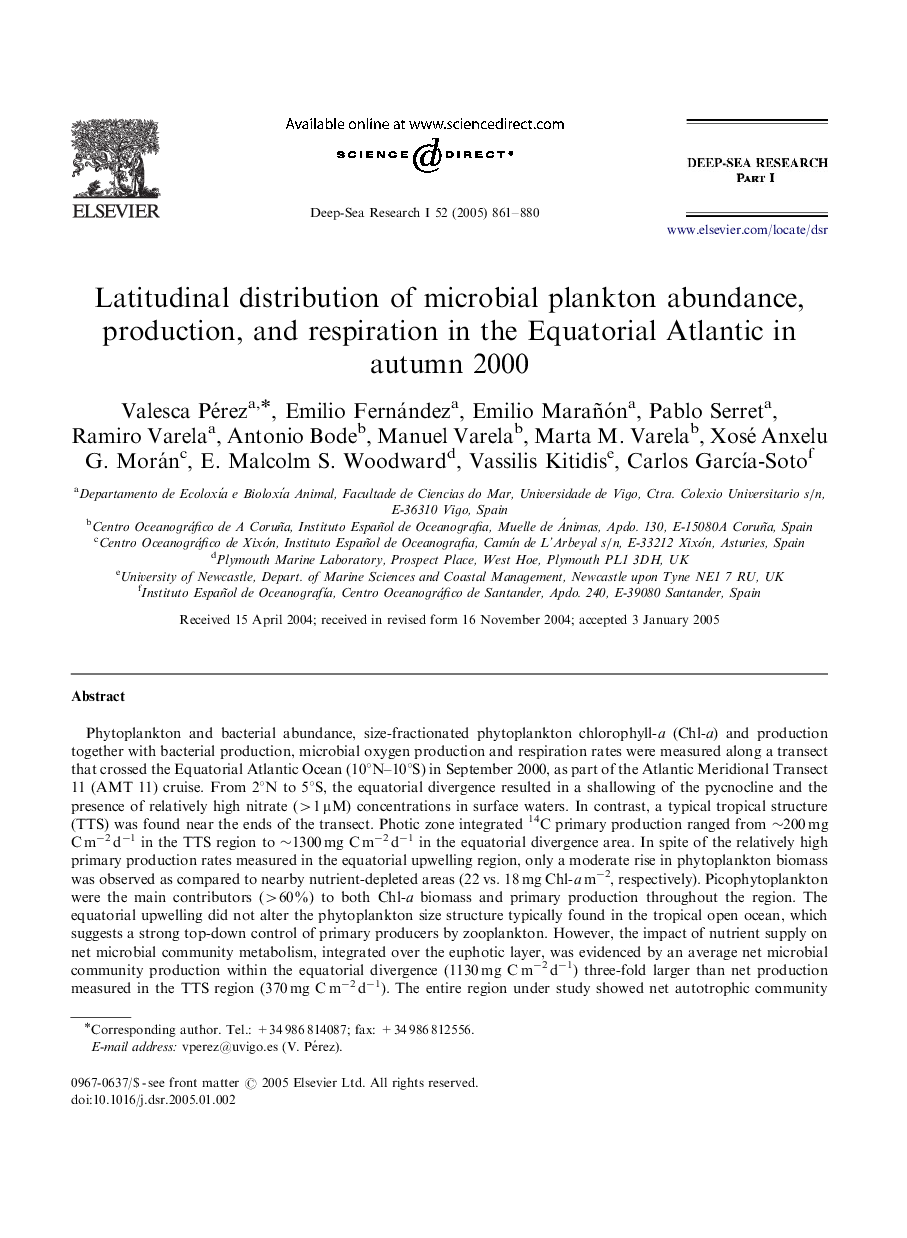| کد مقاله | کد نشریه | سال انتشار | مقاله انگلیسی | نسخه تمام متن |
|---|---|---|---|---|
| 9479588 | 1326117 | 2005 | 20 صفحه PDF | دانلود رایگان |
عنوان انگلیسی مقاله ISI
Latitudinal distribution of microbial plankton abundance, production, and respiration in the Equatorial Atlantic in autumn 2000
دانلود مقاله + سفارش ترجمه
دانلود مقاله ISI انگلیسی
رایگان برای ایرانیان
کلمات کلیدی
موضوعات مرتبط
مهندسی و علوم پایه
علوم زمین و سیارات
زمین شناسی
پیش نمایش صفحه اول مقاله

چکیده انگلیسی
Phytoplankton and bacterial abundance, size-fractionated phytoplankton chlorophyll-a (Chl-a) and production together with bacterial production, microbial oxygen production and respiration rates were measured along a transect that crossed the Equatorial Atlantic Ocean (10°N-10°S) in September 2000, as part of the Atlantic Meridional Transect 11 (AMT 11) cruise. From 2°N to 5°S, the equatorial divergence resulted in a shallowing of the pycnocline and the presence of relatively high nitrate (>1 μM) concentrations in surface waters. In contrast, a typical tropical structure (TTS) was found near the ends of the transect. Photic zone integrated 14C primary production ranged from â¼200 mg C mâ2 dâ1 in the TTS region to â¼1300 mg C mâ2 dâ1 in the equatorial divergence area. In spite of the relatively high primary production rates measured in the equatorial upwelling region, only a moderate rise in phytoplankton biomass was observed as compared to nearby nutrient-depleted areas (22 vs. 18 mg Chl-a mâ2, respectively). Picophytoplankton were the main contributors (>60%) to both Chl-a biomass and primary production throughout the region. The equatorial upwelling did not alter the phytoplankton size structure typically found in the tropical open ocean, which suggests a strong top-down control of primary producers by zooplankton. However, the impact of nutrient supply on net microbial community metabolism, integrated over the euphotic layer, was evidenced by an average net microbial community production within the equatorial divergence (1130 mg C mâ2 dâ1) three-fold larger than net production measured in the TTS region (370 mg C mâ2 dâ1). The entire region under study showed net autotrophic community metabolism, since respiration accounted on average for 51% of gross primary production integrated over the euphotic layer.
ناشر
Database: Elsevier - ScienceDirect (ساینس دایرکت)
Journal: Deep Sea Research Part I: Oceanographic Research Papers - Volume 52, Issue 5, May 2005, Pages 861-880
Journal: Deep Sea Research Part I: Oceanographic Research Papers - Volume 52, Issue 5, May 2005, Pages 861-880
نویسندگان
Valesca Pérez, Emilio Fernández, Emilio Marañón, Pablo Serret, Ramiro Varela, Antonio Bode, Manuel Varela, Marta M. Varela, Xosé Anxelu G. Morán, E. Malcolm S. Woodward, Vassilis Kitidis, Carlos GarcÃa-Soto,